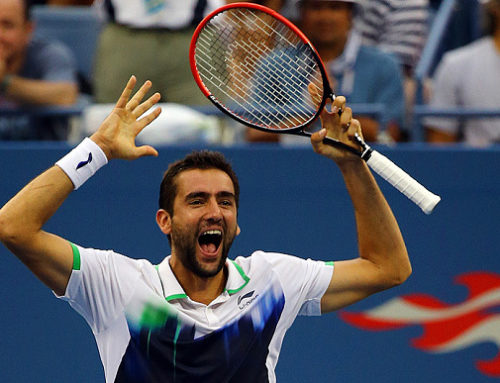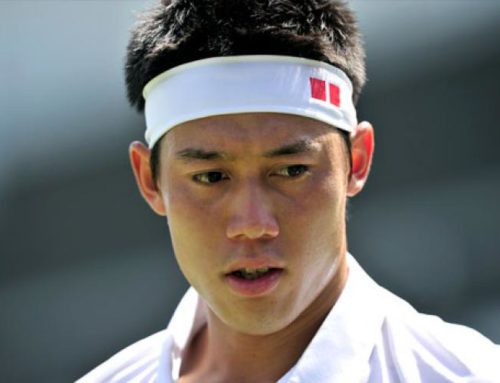Prior to the tournament starting, Monfils-Federer would have promised to be an spectacle. Monfils’ flashy athleticism and Federer’s smooth grace provide a contrast in styles that makes for entertaining tennis. But for all that only the most die-hard Monfils fans would have seen the outcome to be much in doubt. True their three prior Grand Slam meetings all occurred at the French Open on clay, but Monfils had managed to win only a single set against Federer in three tries. Given Monfils’ infamous propensity for mental lapses, the idea of him beating a resurgent Federer over best-of-five at the US Open was dubious at best. But then the tournament started…
Federer’s road to the their Quarter-Final matchup was predictably smooth. After smoothly dispatching back-to-back Australians, he dropped a set to a red-hot Granollers before putting on a three-set clinic to finish the match out 6-1, 6-1, 6-1. A clinical win over Bautista Agut and Federer was through without facing a single seed or any true challenges. Monfils’ road was much tougher. His first two wins over no-name opponents were to be expected (although a shock upset wouldn’t have been so shocking either). But in facing off against Richard Gasquet, Monfils served notice. Although a tight tussle would have been easy to foresee, few would have predicted Monfils to win in straight sets. That he did so with relative ease, 6-4, 6-2, 6-2 was even more surprising. Monfils was not done yet however. In his next match against an on-the-rise Dimitrov Monfils again surprised. The mercurial Frenchman showed uncharacteristic nerves of steel coming through 7-5, 7-6, 7-5. Monfils came to Flushing Meadows to play.
While he did ultimately fall short, Monfils did three critical things extremely well that brought him to the cusp of victory. There can be little doubt that Federer is the technically superior player of the two, so Monfils needed to make this match about something other than pure ball-striking ability. He did so with aplomb, and were it not for the mental lapse we expected eventually rearing its head he probably would have come away with the win. So what was it that Monfils did so well?
1) Used Gamesmanship To Put Federer on Edge
Love it or hate it, Monfils’ use of gamesmanship played a big role in the match. From the get-go Monfils showed a calculated edge in his actions. He took well over the time limit on changeovers, disrupted Federer’s rhythm during service games and just generally did what he could to put Federer on edge. A constant stream of dialogue in French issued forth from Monfils, contributing to create an on-court atmosphere that was contrary to the peaceful calm that normally surrounds the Swiss maestro. To say it worked would be an understatement. After coming out of the gates strongly, Federer quickly became irritated and it showed. He argued with the chair umpire, and was generally uncharacteristically grumpy on the court. Monfils had taken Federer out of his calm center and thus lowered his standard of play.
2) Pulled The Trigger On Forehands
Monfils did an excellent job of disrupting Federer’s rhythm in another way – with his forehand. Historically a defensive counter-puncher, Monfils played with uncharacteristic aggression. He pulled the trigger on forehands consistently throughout the opening sets and hit some thundering winners. More importantly though the change of pace was unsettling to Federer. Set suddenly on his heels in some rallies, he had to respect Monfils’ forehand enough that it affected his movement slightly. We saw later in the match Federer sometimes not even breaking on winners that Monfils hit – not from fatigue but simply because Monfils froze him as a result of balls played earlier in the match.
3) Extended Rallies
This last is what we all expected from Monfils. He is truly a world-caliber athlete. As one of the commentators put it “Usain Bolt with a tennis racquet”, and the observation isn’t too far off the mark. Monfils’ athleticism was on display, and in some rallies he forced Federer to hit 2-3 winner-quality balls to end points. This surely contributed to some of Federer’s errant play, as the Swiss felt pressured to hit closer and closer to lines, and bigger and bigger in order to get the ball by the Frenchman.
Conclusion
When we watch tennis matches too often the focus (especially on the part of commentators) is on how well or poorly each player is playing. What isn’t given enough recognition is the fact that tennis is an interactive sport. Each player can directly influence the other with their actions and this was on display last night. Sometimes a match isn’t just about playing well yourself, it is about finding ways to make your opponent play poorly. After all it is only the better player on the day who wins, not the better player overall. Monfils’ strategy was spot-on and it came within a hair of succeeding. If his nerve had held, he would be looking at a great chance to advance to his first Slam semi-final. Instead he will be left wondering what might have been and Federer’s march towards the title continues.

